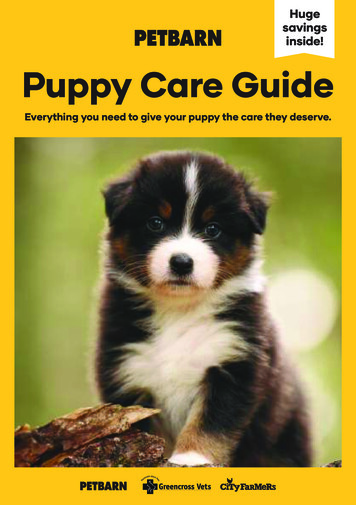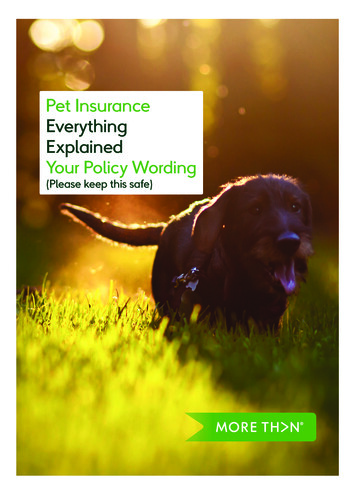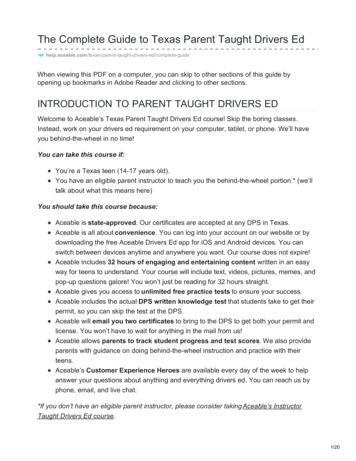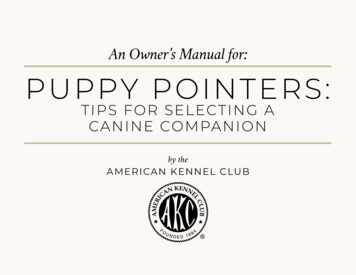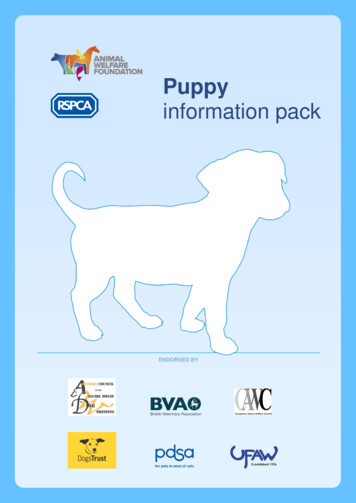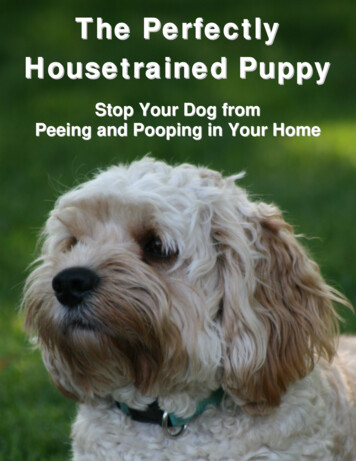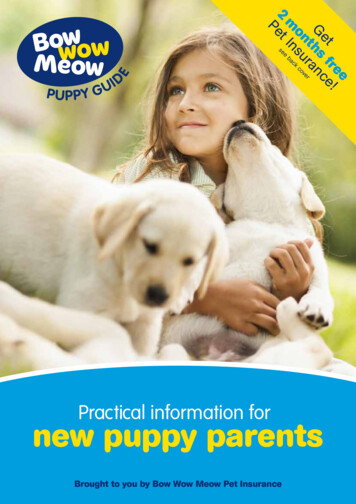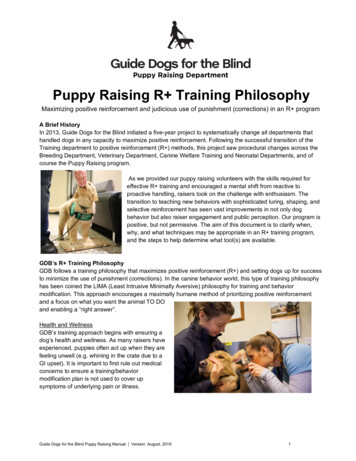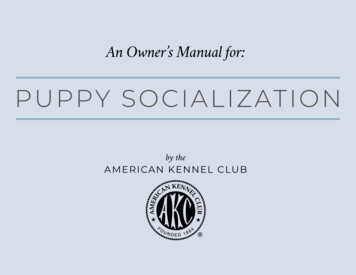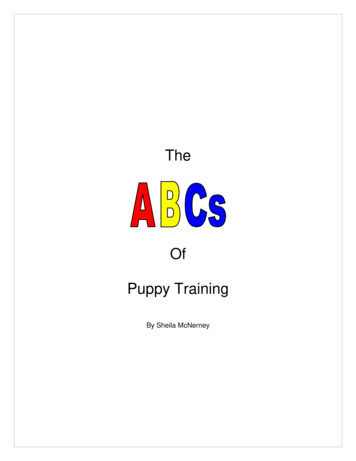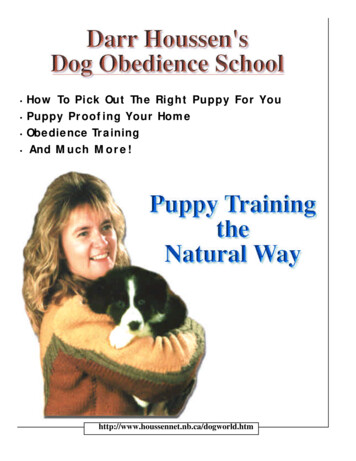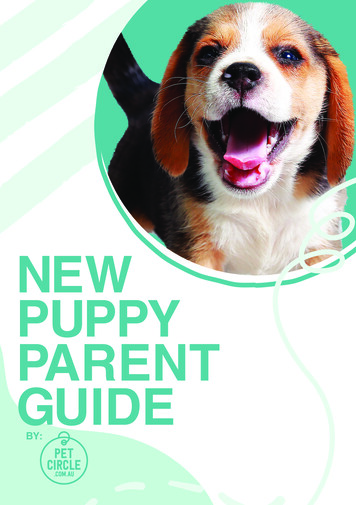
Transcription
NEWPUPPYPARENTGUIDEBY:
CONGRATULATIONS!Bringing home a new puppy is an exciting time and there can bean overwhelming amount of information to take in.We designed this puppy box and guide to make it easy to give yourpuppy the best possible start in life, so you can spend more timegetting to know one another!w w w. pe tc i rcl e . c om . a u3
FOODhave been formulated to account for the rapid growth rate andPuppies need special food to support their increased need forheavier body weight that is placed on their growing skeletons.energy, calcium and other nutrients during growth. Feeding your pupThe main difference between a regular puppy food and a large ora high quality puppy food in their first year of life will set them up forgiant breed puppy food is the energy density, calcium content,a healthy life. Look for premium diets based on scientific researchand the calcium to phosphorus ratio.and development from brands including Hill’s Science Diet, RoyalCanin and Advance.High energy diets and rapid growth are known risk factors fordevelopmental bone and joint diseases in large breed puppies,Science based puppy foods are rigorously tested to ensure safety,so large breed puppy foods are less energy dense to promotequality, nutritional soundness, palatability and digestibility. The endcontrolled bone growth.result is food that tastes great, is gentle on your pup’s tummy anddelivers everything they need to grow and thrive.SMALL BREEDSSmall and toy breed puppies (those with an expected adult weightunder 10kg) mature faster than medium and large breeds, so choosetailored small breed formulas to ensure your pup’s unique nutritionalneeds are met.LARGE BREEDSFor puppies withan expected adultweight over 25kg,we recommendfeeding a tailoredlarge breed puppyQ &AHow often should I feed my puppy?Puppies need to eat more frequently than adult dogs, after all theyonly have tiny little stomachs! Up until the age of about 5 to 6 monthsit’s recommended to split your puppy’s daily feeding amount into 3separate meals.How much should I feed my puppy?The ideal feeding amount will vary from formula to formula anddepends on your puppy’s age and weight. To work out how muchto feed your puppy, consult the feeding guidelines on the foodpackaging and use this as a starting point, adjusting the amount upor down depending on your puppy’s needs. If you need help oraren’t sure how much to feed, check with your veterinarian or ask ourPet Circle Vet Squad for help.diet. These diets4N E W PU P PY PA R E N T G U ID Ew w w. pe tc i rcl e . c om . a u5
HEALTHFLEAS & TICKSFLEA, TICK & WORMINGDepending on the product, flea and tick prevention can be startedTREATMENTSaround 6-9 weeks of age. As previously discussed, you can combineYour puppy needs toflea and tick protection with worming, or you might like to give twobe protected from fleas,separate products. Ask your vet about whether there are ticks,intestinal worms, tapewormparticularly paralysis ticks, in your area.and heartworm. For thoseliving in or visiting the eastcoast of Australia, protectionVACCINATIONS & HEALTH CHECKSagainst paralysis ticks is alsoTypical vaccinations for puppies involve 3 injections spacedextremely important.approximately 4 weeks apart. These usually occur at 6-8 weeks ofage, 12 weeks of age, and 16 weeks of age but can vary dependingINTESTINAL WORMS & TAPEWORMon your location and the type of vaccine your vet uses. Once theYour puppy needs to be wormed:puppy series has been completed your dog will need yearly, or in Every 2 weeks until 12 weeks of agesome cases 3 yearly, vaccinations for life. Every month until 6 months of age Every 3 months after 6 months of age (OR monthly, if you preferto combine with heartworm prevention).In general, dogs in Australia are routinely vaccinated againstCanine Parvovirus, Canine Adenovirus, Distemper and Kennel Cough.Additional vaccinations may be recommended in certain areas soHEARTWORMconsult with your local veterinarian for recommendations specific toHeartworm prevention needs to be maintained for life. You can eitheryour dog’s needs.choose to get your pup an annual heartworm injection at your vet oryou can give a monthly product yourself at home. Monthly productsRemember that vaccinations can take up to two weeks to haveusually combine heartworm with intestinal worming, and some eventheir full effect, so unless your vet has advised otherwise avoidcombine flea and tick treatments in the mix too.taking your puppy out and about, particularly to dog parks,beaches and other dog hotspots until 2 weeks after they havehad their final vaccination.6N E W PU P PY PA R E N T G U ID Ew w w. pe tc i rcl e . c om . a u7
DESEXINGDesexing your puppy before he or she reaches sexual maturitydental health throughout their life. Veterinary dentists recommend(from 4 to 6 months of age) will prevent unwanted pregnancies asdaily tooth brushing as the gold standard for dog dental care,well as reducing roaming behaviour and territorial marking. Not onlyand the earlier you start the easier it will be for your dog to acceptthat, female dogs who are desexed before their second heat have athis. Try to get your puppy used to having their mouth examined andsignificantly reduced risk of mammary cancer and uterine infection.handled from an early age.Male dogs who are desexed are less likely to experience prostateproblems and testicular cancers.Most vets will recommend desexing your puppy at about 5 to 6BATHING & GROOMINGmonths of age, although in some cases puppies can be desexedPuppies have a habit of getting dirty, so you’ll need to keep someas early as 16 weeks depending on the size and breed of the dog.gentle shampoo on standby. As a general rule, aim to bathe yourpuppy about once every 2 weeks or so from the time you bring themhome. Bathing your pup very frequently may dry out their skin whichcan cause itching or flaking. Use a sensitive skin or puppy specificDENTAL CAREformula to help protect that soft skin and keep your pup’s coat smoothYour puppy will start teething from about 12 weeks as their adultand shiny. For quick clean ups in between washes you can also useteeth start to come through. Most of the time owners don’t evenpet cleansing wipes and coat refreshing sprays.notice these baby teeth fall out as they are often swallowed, but don’tbe worried if you find the occasional little tooth around the house!Medium and long haired breeds will need to be brushed daily toprevent knots and matts from forming. They’ll also need to get used toWhile they are teething your pup will probably start to chew onhaving their coats clipped to keep things neat and tidy. Start gettingeverything, so make sure you give them plenty of appropriate chewyour puppy used to being groomed, handled and having their nailstoys to save your shoes and furniture. Until your pup has all theirtrimmed as soon as you bring them home; this will make life muchadult teeth avoid giving harder dental chews or bones as baby teetheasier for you and any dog groomers in the long run!are a little more delicate and may break if they chew hard objects.Once all your puppy’s adult teeth are through (usually by about 6months), it’s time to start thinking about how you will care for their8N E W PU P PY PA R E N T G U ID Ew w w. pe tc i rcl e . c om . a u9
TRAINING &BEHAVIOURcan take time and patience, positive pet parenting will help your dogPOSITIVE PETanxiety or pain.to learn how to behave and interact with people and other animalsappropriately without damaging your relationship or causing distress,PARENTINGPositive or reward basedA handy mantra for positive pet parenting is to train the dog youbehavioural trainingwant - acknowledge and reward behaviours you desire in your dog,is widely accepted toignore and reshape the behaviours that you don’t desire.be the most effectiveand enjoyable way toCLICKER TRAININGencourage dogs to behaveClicker training is a way of signalling desirable behaviour to yourin the ways that we want.dog in order to ‘capture’ it and can help to accelerate training.This concept hinges onA good way to think of the clicker is like a camera that takes a picturecapturing and rewardingof the desired behaviour at the instant it occurs.The clicker is paireddesirable behaviours (withwith positive reinforcement (usually treats) to reinforce and teachtreats and praise) whilethe behaviour.ignoring undesirable ones.Attempting to stop unwanted behaviours by yelling, picking up orinteracting with your dog in any way can actually encourage them;your dog may well see any form of attention as positive reinforcement.The use of physical force such as hitting, kicking or smacking is alsonot an appropriate or humane way to train a dog.In the case of negative behaviours with dogs and puppies, the bestapproach is to ‘shape’ their behaviour by redirecting them away fromthe undesirable behaviour (eg. barking at the neighbours) towardsa learned desirable behaviour (eg. sitting quietly on a mat). While it10N E W PU P PY PA R E N T G U ID Ew w w. pe tc i rcl e . c om . a u11
TOILET TRAININGSLEEPINGThe key to successful toilet training is consistency and patience.Remember that your puppy is doing a lot of growing and developing,You will need to take your puppy outside to the area where you wouldwhich means that he or she will need plenty of sleep at night andprefer them to toilet a lot, ideally every 2 hours for young pups!daytime naps. It’s perfectly normal for young puppies to sleep aboutA good rule of thumb is to take your pup to the toilet whenever they15 to 20 hours a day!wake up from a nap, after eating or drinking, after play sessions or ifthey are showing signs that they need to go such as sniffing aroundIn order to maximise your puppy’s sleep and help them settle quicklythe ground in circles. When you take your pup out to the toilet, avoidat night time, try to stick to a bedtime routine, for example: dinner,the temptation to play with them, simply give a command like ‘go wee’a walk, playtime, a toilet trip and then into the crate or sleeping area.and wait patiently for a few minutes.It’s normal for your pup to wake during the night and need a toiletbreak until about 16 weeks of age.Reward your puppy with plenty of praise every time they do the rightthing. Remember that you’ll need to get up during the night too in theearly months to avoid any accidents in the house.When your pup has a toilet training accident in the house, don’t scoldCRATE TRAININGthem or rub their nose in it as this will only breed anxiety and fear.Crate training is a way to create a safe, personal space for your dogSimply clean up the mess without delay, using an enzymatic cleanerin your home. It draws on your dog’s natural instincts to create a den,to remove the scent which can attract your puppy back to that spota safe refuge in which to sleep and hide. Although adult dogs can beagain next time.crate trained, the ideal time to start is when your dog is a puppy.For puppies in apartments or situations where it is difficult to takeCrate training offers a lot of practical benefits and can be particularlythem outside overnight, you can also train them to use a puppy paduseful with puppies as an aid to toilet training and preventingas an alternative toileting spot. Use the same approach as above todestructive or undesirable behaviours.show your puppy that the pad is the place to go.12N E W PU P PY PA R E N T G U ID Ew w w. pe tc i rcl e . c om . a u13
healthy, fully vaccinated, well socialised dogs you could also askthem to come around for a puppy playdate, just be sure to keep anSOCIALISATIONeye on things to make sure the play doesn’t get out of hand.The first 14 to 16 weeks of your puppy’s life is when they will be mostopen to new experiences and is often referred to as the ‘socialisationAs well as other dogs, try to expose your puppy to as manywindow’. Socialising your puppy involves exposing them to lots ofdifferent people (including the postie and tradesmen and women indifferent environments, things, people and animals in a positive anduniform), sounds (such as the vacuum cleaner or thunder) in a calm,safe way to help them have the best chance of being well adjustedfriendly and non overwhelming environment as you can during thiscanine citizens.socialisation window.As this window coincides with the period of time in which your puppymay not have full immunity and protection from their vaccinations,it’s crucial to choose the location of any socialisation very wisely.TOYSThis is particularly important for avoiding parvovirus, which still killsPlay is essential to keep your puppy physically and mentallyplenty of puppies in Australia every year.stimulated. You will need to stock up on a range of toys and rotatethrough around 2 to 3 on a daily basis to keep your pup interested.Socialising your puppy effectively is more than just chucking themTry to offer a few different types of toys each day, such as chew toys,in the deep end at the dog park! Negative experiences at any timefetch toys, soft cuddly toys, treat dispensingduring their development can stick with a puppy well into adulthood,toys and rope toys.so being beaten up by the local dog park bully is not going to helpyour puppy play well with others later on.Remember that whilemany toys are durable,14To socialise your pup, get in touch with your local vet or dog trainernone are indestructible.about puppy preschool classes. Puppy preschool offers a safe,Always supervise yoursupervised environment where your puppy can meet and play withpup with new toys,other pups (and usually learn a few basic obedience skills andcheck them regularlyhealthcare tips too!). If you have friends or family members withand remove if damaged.N E W PU P PY PA R E N T G U ID Ew w w. pe tc i rcl e . c om . a u15
5.Continue to practice and over time you will find that you no longerneed to ‘lure’ them into the sitting position, and they will respondjust to the voice command.BASIC OBEDIENCEYou can start teaching your puppy basic obedience and ‘manners’ assoon as they come home, beginning with mastering ‘sit’ and walkingon a lead. For best results, join up with a puppy preschool or puppytraining class in your local area.TEACHING YOUR PUPPY TO WALK ON A LEAD1.it on for short periods of time to begin with. If you notice themscratching at the collar try and redirect their attention with aTEACHING ‘SIT’1.Get your puppy used to wearing a simple flat collar by puttinggame or short training session. Once they are used to the collar,Find a space without many distractions so that your pup canyou can start to get them accustomed to the feeling of the leadfocus. Show them a treat to get their interest.dragging behind them. An easy way to do this is to attach thelead and let them run around or play in the backyard under2.While your puppy is focussed on the treat, hold it above theiryour supervision.head so that they look upward. Move the treat backwards, justbehind their nose so that they begin to tilt their head back.Using a treat in this way known as ‘luring’.2.Now you can start to pick up the lead and train them to walkalongside you. Some puppies may just start trotting happilyalongside you, but others can be more challenging. The two3.Your pup will naturally try to get to the treat, and to do this frommain problems that you are likely to encounter are:their current position they will need to put their bottom on thefloor. As soon as this occurs you must ‘capture’ the behaviour. Puppy Sits Down and Won’t Move - This is a commonThis is done by either using a clicker or a praise word (like ‘yes’)response initially, especially if your puppy is in a new andand giving them the treat.potentially scary place. Overcome it by getting down ontheir level and enticing them to move forwards with a treat or4.Repeat step 3 until your puppy seems to understand what it isfavourite toy. As they move forwards give them lots of praise.that you are wanting them to do. Once they understand, you canBe patient and in time you will find that they become morerepeat the process but use the word ‘sit’ as you ask them to sit soconfident about walking with you.that they will associate the action with the command.16N E W PU P PY PA R E N T G U ID Ew w w. pe tc i rcl e . c om . a u17
Puppy Pulls on Lead - Pulling on the lead means your puppyis excited and can’t wait to get out and explore the world!If your puppy begins to pull, stop and call them back to youand praise them when they come. Start walking again, thistime with a handful of treats in the hand closest to the puppy.Lure your pup along with the treats in the desired direction,giving them plenty of praise and a treat every few momentsto reward the behaviour. Once again, if your puppy begins toWith a little patience, preparation and love, your puppy willpull, stop and call them back and repeat the process.grow into a happy, healthy, much cherished family member.Over time you can increase the interval between the treatsfrom a few seconds to a few minutes and then longer as theyFrom all of us at Pet Circle, we wish you and your new puppystart to get the idea. This method will take time and patiencemany happy years together.but is an effective and gentle way to train your puppy to walkat your side. If you are still having trouble with a puppy thatpulls, you could also try using a headcollar or front attachingharness. These are designed to distribute pressure frompulling to bring your puppy’s attention back to you.Dr Teagan Lever BVScPet Circle VeterinarianWalking on a lead can be a challenge for puppies at first, but withperseverance, kindness and some tasty treats as motivation, theywill soon be walking nicely on the lead beside you.Need more help?Scan this code with your phone or visitpetcircle.com.au/vet-pet-plan for apersonalised pet health, lifestyle andnutrition plan from our Pet Circle Vet Squad.18N E W PU P PY PA R E N T G U ID E
YOUR PUPPY’S HEALTH RECORDNAMEFLEA & WORMING TREATMENTSSEXPRODUCTWHAT DOES IT COVERYOUR PUP’SPHOTOBIRTHDATEBREEDCOLOURMICROCHIP #REGISTRYDATEDESEXEDVETERINARIANIMPORTANT DETAILSREGULAR VET CLINIC NAMEVACCINATION RECORDPHONEVACCINEDATEWEIGHTNEXT DUEVETEMERGENCY VETPHONEPET INSURANCE PROVIDERPOLICY NUMBERFREQUENCY
PUP NOTESYou and your new puppy are in this journey together, use this spaceto write your new discoveries, adventures and milestones.
www.petcircle.com.au3/60 Wallgrove Road, Eastern Creek NSW 2770ABN 17 148 151 213E sales@petcircle.com.au P 1300 608 003
The main difference between a regular puppy food and a large or giant breed puppy food is the energy density, calcium content, and the calcium to phosphorus ratio. High energy diets and rapid growth are known risk factors for developmental bone and joint diseases in large breed puppies, so large breed puppy foods are less energy dense to promote
